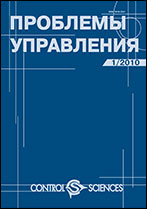|
This article is cited in 2 scientific papers (total in 2 papers)
Reviews
Methods of solving fuzzy systems of linear equations. Part 2. Incomplete systems
N. P. Demenkova, E. A. Mikrinba, I. A. Mochalova
a Bauman Moscow State Technical University
b S.P. Korolev Rocket and Space Corporation «Energia»
Abstract:
The methods of solving incomplete fuzzy systems of linear equations (FSLE) are described using the extension of the original system in the case when it is low dimensional. It is noted that in the Friedman embedding method the fuzzy system is immersed in the traditional one, which can be solved using the traditional methods of linear algebra. The peculiarity of the doubled in the sense of dimensionality traditional system of linear equations is determined by the structure of its matrix. Like in solving the complete FSLE, here too the strong / weak solutions appear. The doubled Friedman embedding method is used to solve the doubled FSLE, which arise in solving the Volterra–Fredholm equations. The Ezzati embedding method is a chain of obvious relationships. The Abbasbandy embedding method is valid when the right-hand side of the FSLE is represented by a vector, each component of which has the membership functions in the form of an isosceles triangle. The main advantage of the center method is the non-use of the augmented matrix and the absence of restrictions on the symmetry of the membership functions of the components of the FSLE right-hand side vector. Methods described are illustrated by examples of solving the problem of fuzzy interpolation and of fuzzy linear regression. In a case of a significant FSLE dimension, the sets of iterative methods are considered for solving them, based on the $Q-T$-decomposition of the initial matrix S of the extended FSLE, when decomposition (splitting) of the matrix S into two matrices $Q$ and $T$ is performed. It is noted that depending on how the matrix $Q$ is specified, there is a set of iterative methods. In the Richardson method, the matrix $Q$ is assumed to be the unit matrix, in the Jacobi method, the matrix $Q$ consists of the diagonal elements of the matrix $S$, in the Gaus–Seidel method the matrix $Q$ is formed from the elements of the lower triangular or upper triangular matrix $S$. The HSS method uses Hermition–Skive splitting of the matrix $S$. The methods of obtaining the pseudo solution of FSLE are described and the traditional methods of linear algebra of obtaining pseudo solutions are listed.
Keywords:
fuzzy systems of linear equations, fuzzy interpolation, fuzzy linear regression, fuzzy iteration methods, fuzzy pseudo-inversions.
Received: 27.12.2018
Revised: 28.02.2019
Accepted: 04.04.2019
Citation:
N. P. Demenkov, E. A. Mikrin, I. A. Mochalov, “Methods of solving fuzzy systems of linear equations. Part 2. Incomplete systems”, Probl. Upr., 2019, no. 5, 19–28
Linking options:
https://www.mathnet.ru/eng/pu1154 https://www.mathnet.ru/eng/pu/v5/p19
|

|




 Contact us:
Contact us: Terms of Use
Terms of Use
 Registration to the website
Registration to the website Logotypes
Logotypes








 Citation in format
Citation in format 
